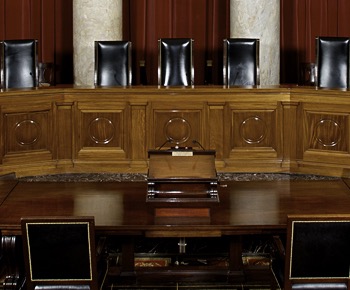SCOTUS refuses to take Sequenom v. Ariosa
 On June 27, 2016, the United States Supreme Court denied certiorari to Sequenom, Inc., which will let stand a decision of the United States Court of Appeals for the Federal Circuit that ruled a truly revolutionary medical test to be patent ineligible.
On June 27, 2016, the United States Supreme Court denied certiorari to Sequenom, Inc., which will let stand a decision of the United States Court of Appeals for the Federal Circuit that ruled a truly revolutionary medical test to be patent ineligible.
The innovation in question is a test for detecting fetal genetic conditions in early pregnancy that avoided dangerous, invasive testing techniques that are potentially harmful to both the mother and the fetus.
The invention, which was embodied in U.S. Patent No. 6,258,540, claimed certain methods of using cffDNA. The patent teaches technicians to take a maternal blood sample, keep the non-cellular portion (which was “previously discarded as medical waste”), amplify the genetic material that only the inventors had discovered was present, and identify paternally inherited sequences as a means of distinguishing fetal and maternal DNA. The claimed method does not preempt other demonstrated uses of cffDNA.
Why courts rely on §101 when other sections of the statute seem far better suited
 Diamond v. Diehr specifically warned about §102 improperly influencing the §101 analysis, so a §101 analysis was presumably considered separate from a §102, §103 or §112 analysis. Fast forward a little more than a generation. In 2012, Mayo Collaborative Services v. Prometheus Laboratories, Inc. was decided by the Supreme Court, which appeared to disregard the warning of Diamond v. Diehr.
Diamond v. Diehr specifically warned about §102 improperly influencing the §101 analysis, so a §101 analysis was presumably considered separate from a §102, §103 or §112 analysis. Fast forward a little more than a generation. In 2012, Mayo Collaborative Services v. Prometheus Laboratories, Inc. was decided by the Supreme Court, which appeared to disregard the warning of Diamond v. Diehr.
Mayo v. Prometheus addressed the question of whether two patents concerning the use of thiopurine drugs to treat autoimmune diseases satisfied the §101 requirement. The Supreme Court ended up holding that the patents were invalid under §101. But its reasoning confused many patent practitioners and litigators. Justice Breyer, writing for a unanimous Court, stated that, because the steps of “administering” and “determining” were well known and conventional, they were not patent-eligible subject matter. This analysis seems to combine the requirement of patent eligibility with that of novelty and nonobviousness. In other words, in Mayo, the Supreme Court did a corollary of what it specifically warned against doing in Diehr.
06.29.16 | patent eligibility, Patent Issues, section 101, Supreme Court Cases | Gene Quinn
Patent Office gives examiners guidance in light of Enfish
 Recently, the United States Patent and Trademark Office (USPTO) sent a memo to the Examining Corps with information and instructions relating to the recent ruling in Enfish, LLC v. Microsoft Corp. by the United States Court of Appeals by the Federal Circuit. In Enfish, the Federal Circuit ruled that the software patent claims at issue were not abstract and were patent eligible. This marked the first time in 18 months, since the Court’s ruling in DDR Holdings in December 2014, that the Federal Circuit has found software patent claims to be patent eligible.
Recently, the United States Patent and Trademark Office (USPTO) sent a memo to the Examining Corps with information and instructions relating to the recent ruling in Enfish, LLC v. Microsoft Corp. by the United States Court of Appeals by the Federal Circuit. In Enfish, the Federal Circuit ruled that the software patent claims at issue were not abstract and were patent eligible. This marked the first time in 18 months, since the Court’s ruling in DDR Holdings in December 2014, that the Federal Circuit has found software patent claims to be patent eligible.
The USPTO memo was authored by Robert Bahr, who is Deputy Commissioner for Patent Examination Policy. As you would expect, it accurately explains the importance of the Federal Circuit ruling in Enfish. Bahr tells examiners that, based on the Federal Circuit ruling, they “may determine that a claim directed to improvements in computer-related technology is not directed to an abstract idea under Step 2A of the subject matter eligibility examination guidelines (and is thus patent eligible), without the need to analyze the additional elements under Step 2B.” (emphasis in the original) Bahr goes on to tell examiners that a claim that is “directed to an improvement to computer-related technology (e.g., computer functionality) is likely not similar to claims that have been previously identified as abstract by the courts.”
06.7.16 | CAFC, Patent Issues, posts, USPTO | Gene Quinn
PTAB denies to institute CBM citing Enfish v. Microsoft
 The Patent Trial and Appeal Board (PTAB) of the United States Patent and Trademark Office (USPTO) recently declined to institute a CBM review of U.S. Patent No. 6,006,227, owned by Mirror World Technologies, LLC. See Apple, Inc. et al v. Mirror World Technologies, LLC. The decision is significant not only because the PTAB refused to institute a covered business method review, but because the panel — Administrative Patent Judges Thomas Giannetti, David McKone, and Barbara Parvis — cited the Federal Circuit’s recent decision in Enfish v. Microsoft when they found that the challenged claims of the ‘227 patent were not abstract.
The Patent Trial and Appeal Board (PTAB) of the United States Patent and Trademark Office (USPTO) recently declined to institute a CBM review of U.S. Patent No. 6,006,227, owned by Mirror World Technologies, LLC. See Apple, Inc. et al v. Mirror World Technologies, LLC. The decision is significant not only because the PTAB refused to institute a covered business method review, but because the panel — Administrative Patent Judges Thomas Giannetti, David McKone, and Barbara Parvis — cited the Federal Circuit’s recent decision in Enfish v. Microsoft when they found that the challenged claims of the ‘227 patent were not abstract.
The Petitioners argued that the challenged claims are directed to an abstract idea that is not patent-eligible subject matter. According to the Petitioners, “the challenged claims of the ‘227 patent are directed to the abstract idea of organizing items of information, i.e., ‘data units,’ in chronological order.” The patent owner responded that the Petitioners’ view “entirely omits the core concept of the claimed invention: using a ‘main stream’ and ‘substreams.’”
06.5.16 | posts | Gene Quinn
Federal Circuit finds data storage software claims patent eligible
 Several weeks ago, the United States Court of Appeals for the Federal Circuit shook up the patent world with a somewhat unexpected gift for patent owners, particularly patent owners and applicants seeking software patents. The Court issued an important decision on software patent eligibility in Enfish LLC v. Microsoft.
Several weeks ago, the United States Court of Appeals for the Federal Circuit shook up the patent world with a somewhat unexpected gift for patent owners, particularly patent owners and applicants seeking software patents. The Court issued an important decision on software patent eligibility in Enfish LLC v. Microsoft.
The opinion by Judge Hughes, who was joined by Judge Moore and Judge Taranto, doubles the total of Federal Circuit decisions where claims in a software patent were deemed to be patent eligible because they are not abstract. In other words, DDR Holdings is no longer the only point of hope for innovators and patent owners in the software space.
This case stared when Enfish sued Microsoft for patent infringement. The patents at issue were U.S. Patent No. 6,151,604 and U.S. Patent No. 6,163,775, both issued in late 2000 and both claiming priority to the same application filed in March 1995. The ’604 and ’775 patents are directed to an innovative logical model for a computer database. A logical model is a model of data for a computer database explaining how the various elements of information are related to one another. Contrary to conventional logical models, the patented logical model includes all data entities in a single table, with column definitions provided by rows in that same table. The patents describe this as the “self-referential” property of the database.
06.3.16 | CAFC, Patent Issues, section 101, software patents | Gene Quinn


No Comments
07.5.16 | Biotech, biotechnology patents, patent eligibility, Patent Issues, posts, section 101, Supreme Court Cases | Gene Quinn